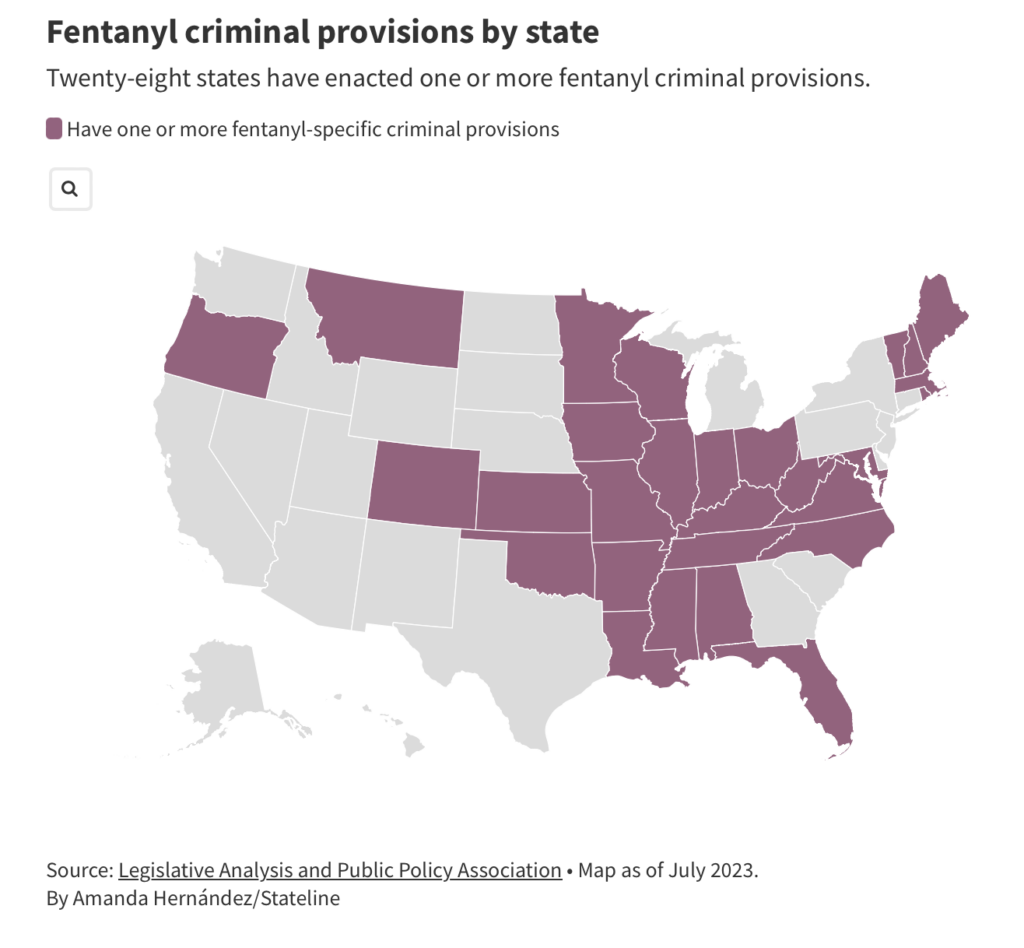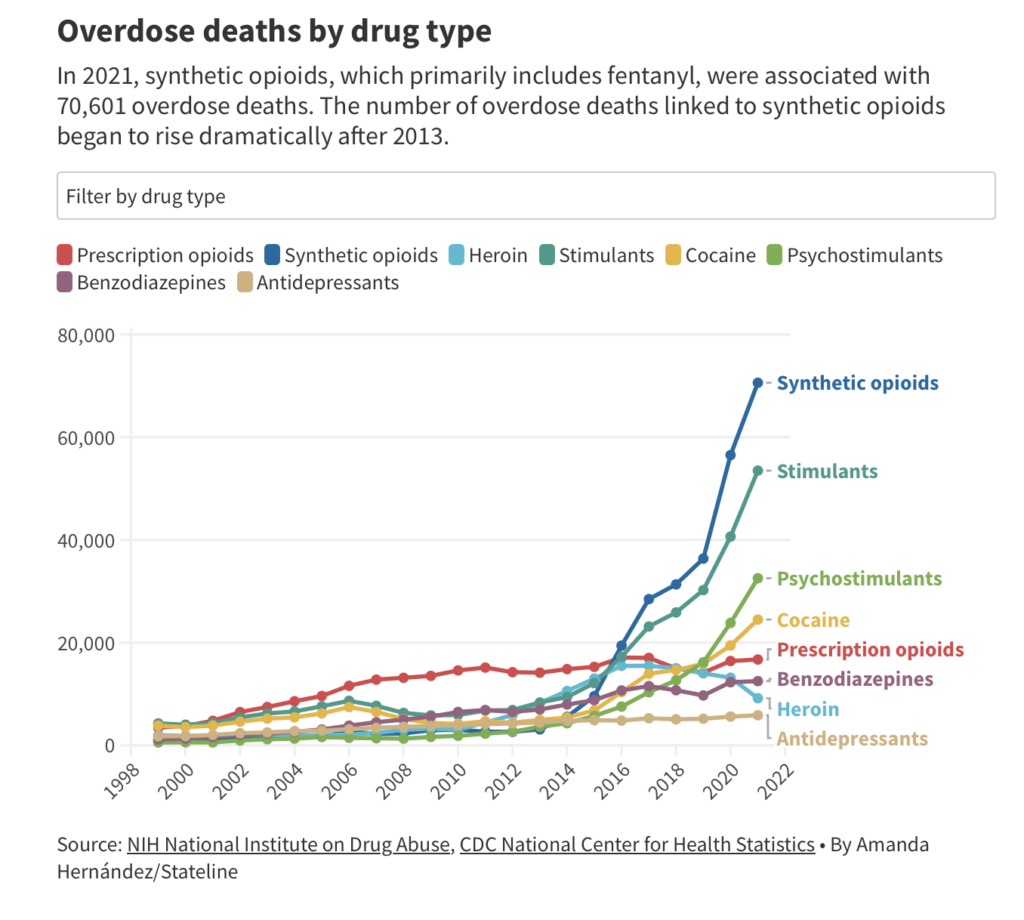
As they struggle to reduce drug overdose deaths, policymakers across the United States are embroiled in a heated debate over creating and increasing criminal penalties related to fentanyl, a powerful synthetic opioid that’s up to 100 times more potent than morphine.
Legislators pushing the new wave of criminal penalties say the laws will deter drug distributors and hold offenders accountable. But opponents — including some public health officials — warn of potential consequences such as worsening the opioid crisis and pushing users toward more dangerous synthetic alternatives.
As of this month, 28 states have enacted one or more fentanyl criminal provisions, according to the Legislative Analysis and Public Policy Association, which researches and drafts potential legislation on public safety and substance use.
In this year’s legislative sessions alone, lawmakers introduced hundreds of fentanyl crime bills in at least 46 state legislatures, according to the National Conference of State Legislatures. While they vary, the bills generally would increase or stiffen penalties for the illegal production, possession and distribution of the substance.
Lawmakers in Virginia designated fentanyl as “a weapon of terrorism,” enacting a bill this spring that makes knowingly manufacturing or distributing substances containing any detectable amount of fentanyl punishable by up to 10 years of jail time.
An Iowa statute, signed into law in May, enhanced the penalties for selling and manufacturing fentanyl, with prison sentences ranging from up to 10 years to up to 50 years. While the bill passed with bipartisan support, some Democrats also proposed that the state improve access to substance use treatment and resources, such as fentanyl testing strips, which remain illegal in Iowa.
You cannot deal with fentanyl without dealing with the overall issue of drug addiction and drug usage.
– Texas state Democratic Rep. Gene Wu
Arkansas and Texas are the latest states to pass legislation that makes it a homicide to give fentanyl to someone who then dies of an overdose. About 30 other states and the District of Columbia have laws, known as drug-induced homicide laws, that allow murder prosecutions, even in cases where individuals share drugs socially, if those drugs contain lethal doses.
Texas’ new law imposes harsher penalties, including first-degree felony charges for those involved in manufacturing, distributing or possessing with intent to deliver between 200 and 400 grams of fentanyl, and second-degree felony charges for those involved in manufacturing or distributing fentanyl that results in an overdose.

The law’s supporters say the measure will not only protect Texans from potentially overdosing, but also hold distributors accountable.
“The intent is to deter the behavior and make it to where prosecutors throughout the state can take the sort of action that needs to be taken with this drug,” Texas Rep. David Cook, a Republican who co-authored the bill, said in an interview with Stateline. “This is a necessary measure in order to protect the public safety of our citizens.”
Republican state Rep. Kronda Thimesch, who also co-authored the bill, wrote in an email that the law garnered “overwhelming support” from families, community leaders and law enforcement agencies across the state.
“We have learned from the past that stronger penalties do work. We need to use every resource available to go after drug dealers,” Thimesch wrote.
But critics raise concerns over whether these types of measures truly address the root causes of substance use.
“You cannot deal with fentanyl without dealing with the overall issue of drug addiction and drug usage,” Texas state Rep. Gene Wu, a Democrat who voted against the measure, said in an interview with Stateline.
“If you make illegal things that human beings want, you will make things worse,” Wu said. “You will create more organized crime, you will create more unintended consequences, you will create more disparity and destruction in poor communities, because this crap never affects the communities of the people who make the laws.”
Some criminal justice advocates say fentanyl should be treated as a public health issue rather than a law enforcement problem.
By attaching criminal consequences to drug-related incidents, fear and stigma may deter people with substance use disorders from reaching out for help, said Maritza Perez Medina, the director of federal affairs for the Drug Policy Alliance, which advocates for reducing criminal drug penalties.
“Public health interventions, things like harm reduction services would actually go a long way in curbing overdose deaths and connecting people to treatment. Unfortunately, that’s not the route that many lawmakers both at the state and federal level are choosing to follow,” Perez Medina said in an interview with Stateline. “There’s still an overinvestment in criminal justice approaches at the expense of public health solutions.”
Criminalization measures also have a disproportionate impact on marginalized communities, which amplify existing racial and socioeconomic disparities, Perez Medina said.
“[These criminalization policies are] also falling on people who are on the lowest level of the drug distribution chain, people who probably also use drugs who would benefit most from public health interventions rather than handcuffs,” she said.
More overdoses
Fentanyl, originally developed in 1959 and introduced in the 1960s, emerged as an intravenous anesthetic and is used particularly to relieve pain after operations, according to the federal Drug Enforcement Administration. Fentanyl also serves as a medication for patients with chronic pain who have developed a tolerance to other opioids.
Before 2013, overdose outbreaks linked to illegally manufactured fentanyl were often localized and attributed to specific chemists in Mexico or elsewhere, according to Beau Kilmer, the co-director of the RAND Drug Policy Research Center, a nonpartisan research group.
A shift occurred when illegally manufactured fentanyl began flowing into the United States from China in 2013, leading to its widespread distribution, Kilmer said. Over time, dealers mixed fentanyl with heroin and later transitioned to counterfeit pills.

More than 110,500 people in the United States died of drug overdoses in 2022, according to provisional statistics released by the National Center for Health Statistics, a federal agency. Sixty-eight percent, or 75,778, of those deaths involved synthetic opioids, such as fentanyl. The Drug Enforcement Administration also attributes more deaths to illegal fentanyl among Americans under 50 than any other cause of death.
The use of fentanyl laced with xylazine — a cheap animal sedative not meant for human consumption that can cause blackouts and lesions that sometimes result in amputations — also is on the rise, causing growing concerns among policymakers. The Biden administration recently unveiled a plan to curb the growing threat by increasing testing and coordinating standardized data collection to better understand how xylazine-related overdoses are affecting the country.
Several states also have taken steps to restrict access to xylazine, also known as “tranq.” Pennsylvania Democratic Gov. Josh Shapiro announced the addition of xylazine to the state’s controlled substances list in April, joining Ohio and West Virginia, where similar restrictions have been implemented. Florida already categorizes xylazine as a Schedule I controlled substance.
Alternative approaches
A recent study published in the American Journal of Public Health suggests that drug busts and police crackdowns on dealers may worsen the overdose crisis.
The research, conducted in Indianapolis, identified a pattern where overdose rates involving opioids doubled in the vicinity surrounding a drug seizure and persisted over several weeks. The study suggested that the increase in overdoses may be linked to people seeking alternatives due to the loss of their stable supply, without knowing their tolerance to other opioids that have varying potency.
Some drug policy experts worry that criminalizing fentanyl may push individuals toward more dangerous substances, as suppliers seek to evade law enforcement scrutiny.
“Anytime you ban a drug, if people respond to that at all, they just respond by using a whole different drug. It doesn’t address the issue because it doesn’t address demand, and as long as there is a demand for the drug, there will be a supply for it,” said Katharine Harris, a drug policy fellow at Rice University’s Baker Institute for Public Policy, in an interview with Stateline.
She also argued that the focus on this substance alone does not address the root causes and complexities of the overdose crisis.
“We’re always going to be one step behind and I feel like that’s what we’re seeing right now with xylazine,” Harris said.
Some states have chosen to pursue alternative approaches. California and North Carolina have embraced harm reduction strategies, such as syringe exchange programs and increasing distribution of naloxone, an overdose-reversal drug. New Hampshire also recently outlined its plan to use $6.5 million to fund programs that aim to treat and prevent substance use in the state.
Missouri recently became the latest state to decriminalize fentanyl testing strips. Only New York City and Rhode Island have legalized “safe injection sites,” where people can use drugs under the supervision of trained staff who can reverse overdoses.
There are more than 1,100 communities nationwide that have committed to creating non-arrest pathways into treatment and recovery to address substance use, according to Zoe Grover-Scicchitano, the executive director of the Police Assisted Addiction and Recovery Initiative, which helps law enforcement agencies turn to treatment programs rather than arrests.
“Effective drug policy, including addressing root causes of addiction and supporting harm reduction efforts, requires creating public health and public safety partnerships. Collaboration between law enforcement and other stakeholders can reduce stigma, create more pathways into treatment and reduce overdose deaths,” Grover-Scicchitano wrote in an email.


